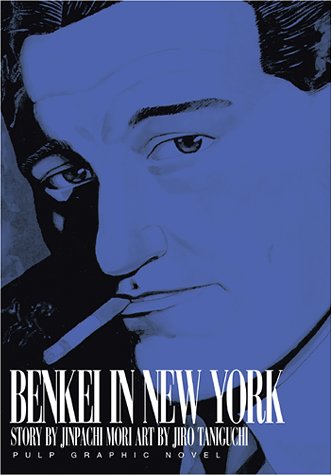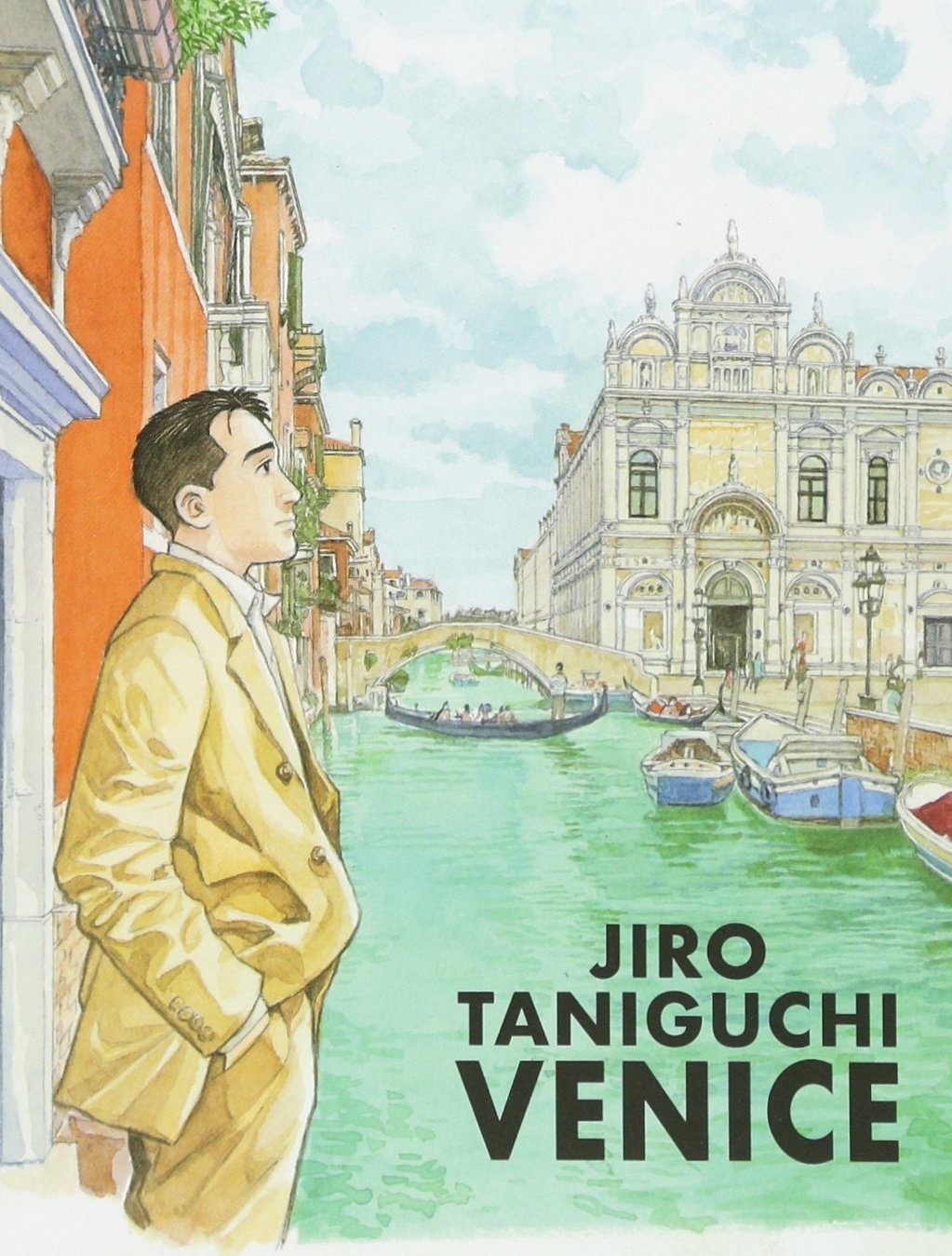I’ve always thought that I had something in common with Warren Ellis — besides a sailor’s fondness for colorful language, that is — and reading Benkei in New York confirmed my suspicions: we both like Jiro Taniguchi. Flip to the back cover of the VIZ Pulp edition, and you’ll see Ellis declaring that “Benkei is better than 96% of the crime fiction coming out of America right now.” I have no idea how he arrived at that figure, but eleven years after Benkei’s initial US release, I’m still inclined to agree with him.
Originally serialized in Big Comic Original, Benkei in New York (1991-96) is a collaboration between Taniguchi and writer Jinpachi Mori, best known in Japan for Kasai no Hito, a long-running manga about an eccentric but wise judge. The seven Benkei stories focus on a Japanese ex-pat living in New York. Like many New Yorkers, Benkei’s career is best characterized by slashes and hyphens: he’s a bartender-art forger-hitman who can paint a Millet from memory or assassinate a thug using a swordfish. (Let’s just say they call it “swordfish” for a reason.)
Benkei’s primary job, however, is seeking poetic justice for murder victims’ families. Of course, there wouldn’t be much of a story if Benkei simply used a gun; part of the series’ allure is watching him set elaborate traps for his prey, whether he’s borrowing a page from the Titus Andronicus playbook or using a grappling hook to wound an unscrupulous dockworker. In “Haggis,” for example, Benkei uses a draft-dodger’s memories of a 1968 trip to Scotland to win the man’s confidence, persuading him to visit an out-of-the-way bar where a gruesome dish awaits him. “Throw Back,” another stand-out, culminates in an elaborate showdown in the American Music of Natural History that gives new meaning to the phrase “interactive exhibits”; Benkei and his victim plunder display cases for weapons, dueling their way through the Hall of Human Origins.
As the scene in the Natural History Museum suggests, New York City is as much a “character” as Benkei himself. Taniguchi clearly spent hours poring over photographs of the city: his rendition of Coney Island, for example, doesn’t just show the Cyclone — an easy symbol for this iconic stretch of New York coastline — but all the bathhouses, apartment buildings, and other structures that line the boardwalk, including the distinctive facade of the New York Aquarium. Moreover, he captures the feeling of Coney Island in the off-season — the dark grey color of the ocean, the empty expanses of boardwalk, the absence of people — imbuing the scene with a melancholy authenticity.
Taniguchi’s eye for detail is evident in his busier scenes as well. In the opening pages of “Throw Back,” Benkei pursues his mark through the 42nd Street subway station. A series of narrow, horizontal panels convey the bustling energy of the platform, cross-cutting between a busker pounding on plastic drums (a subway fixture in the 1990s) and Benkei threading his way through the commuters. Taniguchi swiftly pulls back from extreme close-ups of the the drummer and Benkei to crowd scenes, in so doing helping us see this claustrophobic, noisy space as Benkei does: camouflage for the urban hunter.
Like many VIZ manga from the 1990s and early 2000s, Benkei in New York boasts a stylish translation. (Yuji Oniki is credited as the adapter.) The script crackles with wit and energy, as Benkei trades one-liners with clients and targets alike. One of my favorite exchanges occurs early in the volume, as Benkei talks business with the leader of an art forgery ring:
Forger: Timing is of crucial importance. Once we agree on a deal, it’s our responsibility to deliver the product to the client while they’re still drooling.
Benkei: You sound like you run a pizza joint.
Forger: What’s wrong with that? Selling pizzas is how I learned everything about New York.
Hokey as that conversation may be, it wouldn’t be out of place in a gangster flick; one could almost imagine a character in Goodfellas or The Godfather reminiscing about his past in a similar fashion.
If Benkei’s motives and methods are sometimes inscrutable — or downright illogical — the stories still work beautifully, with crack pacing and memorable denouements that can be as deeply unsettling as they are emotionally satisfying — or, in Warren Ellis’ words, Benkei in New York is “diabolically well-told.” Couldn’t have said it better myself.
BENKEI IN NEW YORK • STORY BY JINPACHI MORI AND ART BY JIRO TANIGUCHI • VIZ • 224 pp. • RATING: MATURE (18+)





david brothers says:
Well, I’m sold. I love crime, I love New York… I’ll have to pick this up.
Katherine Dacey says:
It’s not hard to come by—I think the used copy I bought set me back about $4.00 on Amazon.
slayra says:
Hmm… sounds good but I read manga because it’s different from american comics (just as I read any other non-american comics, I suppose). It portrays situations we know well from a different point of view, culturally (even if it is sometimes exagerated and not quite real by japanese standards). Reading a manga that seems to portray american life in an american setting and is even a crime story doesn’t seem very appealing. Might be missing something, though. Perhaps the author(s) have a fresh (sometimes mistaken) idea of life in America? Or is the hero original in his ideas because he is Japanese? Just my two cents. Still, not denying it’s probably better than many mainstream manga in terms of plot or art, just not as… japanese? Dunno if I’m making sense, lol.
Katherine Dacey says:
Hi there! Your comments make complete sense; I also enjoy manga because it depicts things I don’t see in American comics (e.g. supernatural characters with origins in Japanese folklore, historical figures from the Warring States period). I will say, however, that Mori and Taniguchi’s approach to the material is thoroughly Japanese, even if the setting is American. A lot of that has to do with the the visuals; few American comics have as many wordless sequences as Benkei in New York does. Mori trusts Taniguchi’s images to do the bulk of the storytelling, something I see much less often in Western comics, which tend to put the images and the dialogue on equal footing.
slayra says:
Hmm… I see. I guess it’s worth a try then. I was just wondering if such a comic might ‘feel’ too american but it seems not. ^_^ Thank you for replying.
Maty says:
I’ve always sort of had a thing for Noir and Noir-ish, even the contemporary (Chinatown) or sci-fi (Blade Runner. Leviathan Wakes). Kurosawa’s Stray Dog has always been one of my favorites of his films- I guess I have an alley and this manga seems up it!
Katherine Dacey says:
I’m a fan of Straw Dogs and High and Low, if that’s any help in figuring out whether Benkei is up your alley.